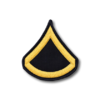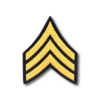Difference between revisions of "Pathfinder Platoon"
| Line 9: | Line 9: | ||
'''Pathfinder Platoon Leader (2LT)''' | '''Pathfinder Platoon Leader (2LT)''' | ||
The Pathfinder Platoon Leader is responsible for ensuring the Pathfinder Platoon's mission is secure and the lines of communication to command are secure. Platoon Leaders shoulder the responsibility for the planning and make executive decisions on the ground in regards to the mission and objectives. This position is usually held by a Second Lieutenant or higher. | The Pathfinder Platoon Leader is responsible for ensuring the Pathfinder Platoon's mission is secure and the lines of communication to command are secure. Platoon Leaders shoulder the responsibility for the planning and make executive decisions on the ground in regards to the mission and objectives. This position is usually held by a Second Lieutenant or higher. | ||
'''Pathfinder Team Leader (SGT)''' | '''Pathfinder Team Leader (SGT)''' | ||
| Line 32: | Line 32: | ||
|} | |} | ||
The | The Pathfinder Platoon is split into three main roles. Pathfinder Leadership rotates, the Platoon Leader is a secondary DMOS billet that can be inhabited by any NCO rank. The Pathfinder PL (Platoon Leader) is the administrative and organizational heart of the Pathfinder Platoon. | ||
Pathfinder Team leaders are the ground leaders that ensure the plan is followed, and if it can't be followed the plan is effectively remediated. The Pathfinder Teams operate at a high level of competency and are highly malleable to the specifications of the mission. | |||
Pathfinders themselves are the team members that complete the actual mission, spotting out enemy positions and marking terrain features to send up to platoon leaders. The Pathfinders are expected to be able to switch out with Pathfinder Team Leaders at any time. | |||
||[[File:PathfinderBadge.png|center|frameless|184x184px]] | ||[[File:PathfinderBadge.png|center|frameless|184x184px]] | ||
The mission of the United States Army Pathfinder School is to train personnel in the U.S. Army and its sister services in a three-day course, during which the candidate pathfinder learns how to navigate dismounted, establish and operate a day / night helicopter landing zone, establish and operate day / night parachute drop zones (DZs), conduct sling load operations, provide air traffic control (ATC) and navigational assistance to rotary wing (RW) and fixed wing (FW) airborne operations. | |||
Pathfinders are also expected to be capable of forward reconnaissance and employing infiltration tactics to remain undetected whilst marking out enemy positions and terrain features. Pathfinders are also expected to be competent soldiers, excellent marksmen, and dangerous saboteurs. Pathfinders going through the school will be expected to do everything from plant charges to eliminate targets completely depending on the mission's specifics. | |||
Pathfinder School also tests a soldier's base of knowledge. Understanding map reading, the NATO identification system, vehicle identification, and the tactical knowledge to ascertain what they can not see. Pathfinders must be alert, and aware at all times and during Pathfinder School they will be checked on the spot to test their base of knowledge and ensure proper retention of material. | |||
|- | |||
| | |||
| | |||
|} | |} | ||
Revision as of 03:35, 22 August 2021
| Pathfinder Platoon | |
| Superior Department | Battalion HQ |
| HQ Staff | |
| Pathfinder Platoon Leader | 2LT E. Geneva |
|---|---|
| Pathfinder Team Leader | [] |
| Pathfinder Team Leader | [] |
Pathfinders are the elements inserted before combat operations begin within an Area of Operations (AO) to perform reconnaissance, mark landing zones, and completely special mission-specific objectives that may arise during a deployment. Pathfinders are expected to be well-versed in enemy identification, stealth, land navigation and map reading along with military freefall skills. Prospective Pathfinders go through Pathfinder School in order to become qualified and capable members of the Pathfinder Platoon.
Mission
To be awarded the Pathfinder Badge, the soldier must complete Pathfinder School. The school instructs advanced land navigation, advanced reconnaissance, tactical air traffic control in the field, and the control of parachute operations; the badge is awarded on completing several examinations under Field Training Exercise (FTX) conditions. Examinations include proficiency in sling load rigging and execution, planning and execution of Helicopter Landing Zones (HLZ), Drop Zones (DZ), air traffic control operations, aerial delivery of troops and supplies, and several others various tasks. Pathfinders are expected to be capable of advanced military freefall and combat dives to infiltrate behind enemy lines, and prepare Alpha Company for Air Assault and Airborne operations. Pathfinders also brief Hotel Company before these operations and provide details on possible terrain and Anti-Aircraft Artillery (AAA) threat considerations.
Pathfinder Platoon Positions
The Pathfinder Platoon is structured to ensure proper chain of command is followed during combat operations.
Pathfinder Platoon Leader (2LT)
The Pathfinder Platoon Leader is responsible for ensuring the Pathfinder Platoon's mission is secure and the lines of communication to command are secure. Platoon Leaders shoulder the responsibility for the planning and make executive decisions on the ground in regards to the mission and objectives. This position is usually held by a Second Lieutenant or higher.
Pathfinder Team Leader (SGT)
Pathfinder Team Leaders execute the orders of the Platoon Leader and ensure that orders are followed. The situation within AOs change rapidly and the Team Leaders are responsible for ensuring that the Pathfinders themselves understand the situation and can properly adapt to them. Team Leaders are tasked with mapping out and communicating enemy positions and marking the any required helicopter landing zones. This position is usually held by a Sergeant or higher. This positions report directly to the Pathfinder Platoon Leader.
Pathfinder (PFC)
The Pathfinders are team members that are responsible for the actual reconnaissance and scouting that goes into a Pathfinder Operation. Pathfinders are expected to be well-versed in everything related to reconnaissance, scouting, stealth, and land navigation whilst also displaying high levels of competency and comprehension of their mission and objectives. This position is usually held by a Private First Class or higher.
| Pathfinder Platoon Positions | Pathfinder School | ||||||
The Pathfinder Platoon is split into three main roles. Pathfinder Leadership rotates, the Platoon Leader is a secondary DMOS billet that can be inhabited by any NCO rank. The Pathfinder PL (Platoon Leader) is the administrative and organizational heart of the Pathfinder Platoon.
|
The mission of the United States Army Pathfinder School is to train personnel in the U.S. Army and its sister services in a three-day course, during which the candidate pathfinder learns how to navigate dismounted, establish and operate a day / night helicopter landing zone, establish and operate day / night parachute drop zones (DZs), conduct sling load operations, provide air traffic control (ATC) and navigational assistance to rotary wing (RW) and fixed wing (FW) airborne operations. Pathfinders are also expected to be capable of forward reconnaissance and employing infiltration tactics to remain undetected whilst marking out enemy positions and terrain features. Pathfinders are also expected to be competent soldiers, excellent marksmen, and dangerous saboteurs. Pathfinders going through the school will be expected to do everything from plant charges to eliminate targets completely depending on the mission's specifics. Pathfinder School also tests a soldier's base of knowledge. Understanding map reading, the NATO identification system, vehicle identification, and the tactical knowledge to ascertain what they can not see. Pathfinders must be alert, and aware at all times and during Pathfinder School they will be checked on the spot to test their base of knowledge and ensure proper retention of material. | ||||||
Policies and Procedures
Pathfinder Platoon utilizes documents and procedures related to proper conduct in the field.
| Document Number | Policy or Standard Operating Procedure |
| 2NDRB-PP-001 | |
| 2NDRB-PP-002 |
Regimental Policies and Procedures
2nd Battalion, 75th Ranger Regiment unit wide policies and procedures governing all personnel.
| Document Number | Policy or Standard Operating Procedure |
| 2NDRB-R-01 | General Orders |
| 2NDRB-R-02 | Ranks & Insignias |
| 2NDRB-R-03 | Medals & Awards |
| 2NDRB-R-04 | Multi-Clan Policy |
| 2NDRB-R-05 | Attendance Policy |
| 2NDRB-R-06 | Discharge Policy |
| 2NDRB-R-07 | Disciplinary Policy |



